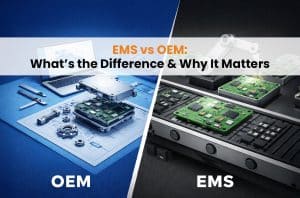In 2025, this landscape of electronics manufacturing is pacing at an unprecedented rate. Now, with technology emerging and increases in global demand, the electronics manufacturing industry takes a shift, embracing innovations defining efficiency, sustainability, and function. In this blog, we will explore the key electronic manufacturing trends that are shifting the future along with IoT for EMS and evolving PCB assembly in EMS.
Key Trends in Electronic Manufacturing for 2025
Revolutionizing Connectivity
The integration of the Internet of Things (IoT) into Electronic Manufacturing Services is a game-changer. The IoT enables device-to-device, component-to-component, and system-to-system communication for manufacturers to see processes in real-time. This makes it efficient with reduced downtime and informs better decision-making through data analysis.
IoT in EMS also enables predictive maintenance, which allows manufacturers to identify potential equipment failures before they happen. IoT minimizes disruptions, thereby boosting productivity and reducing operational costs. Furthermore, IoT-driven smart factories are leading the charge toward Industry 4.0, where interconnected systems deliver unparalleled agility and adaptability.
For instance, sensors in the production lines may be IoT sensors that can monitor the performance of PCB assembly processes to ensure quality control and minimal defects. Such monitoring and optimization are the new standards of electronic manufacturing trends for 2025.
Advanced PCB Assembly Techniques
PCB assembly continues to be at the heart of electronic manufacturing and is what has been driving this industry forward. In 2025, there will be a major push toward automation and precision in PCB assembly processes. Surface Mount Technology (SMT) continues to evolve toward greater sophistication; machines are placing components at lightning speed with near-perfect accuracy.
Another trend is the use of flexible PCBs, which are lightweight, durable, and ideal for compact devices. As wearable technology and IoT devices become more popular, the demand for flexible and miniaturized PCBs is skyrocketing. In addition, innovations like vapor phase soldering and conformal coating are enhancing the reliability and longevity of electronic products.
AI and machine learning are also being incorporated into PCB assembly processes to detect anomalies and optimize workflows. This means that every circuit board is produced with the highest standards of quality and performance, as demanded by the latest electronic manufacturing trends.
Sustainability is the center of focus nowadays, with more and more global environmental concerns arising, and companies have started adopting greener electronic manufacturing. The key practices in terms of being environment-friendly are through recyclable materials, energy consumption, and waste management. This way, they follow the regulations imposed by the governments and also meet consumer demands for environmentally friendly products. PCB assembly is attaining sustainability through innovative materials and processes.
IoT in EMS
IoT plays a pivotal role in enabling customization. By collecting and analyzing customer data, manufacturers can design and produce electronics that cater to specific needs. This trend not only enhances customer satisfaction but also opens new revenue streams for manufacturers.
The Role of AI and Automation Artificial intelligence (AI) and automation are redefining how electronics are manufactured. From design to production, AI-powered tools are streamlining operations and improving efficiency. Automated systems are handling repetitive tasks, freeing up human resources for more complex problem-solving.
In PCB assembly, AI optimizes component placement, reduces waste material, and ensures quality is consistent. In addition, automation makes production lines more agile to respond quickly in case of fluctuations in demand or supply chain disruption. These are the electronic manufacturing trends of 2025 that give a peek into a smarter, faster, and more efficient future of production processes.
Challenges and Opportunities
These trends are exciting but also challenging. The introduction of IoT in EMS requires considerable investment in infrastructure and cybersecurity measures. Similarly, PCB assembly demands skilled labor and training to stay updated with the new technologies.
The benefits of these electronic manufacturing trends are enormous, far outweighing the risks. The companies embracing them will get ahead of their competition, operate with greater efficiency, and deliver to the demand of innovative and sustainable products.
Conclusion
With 2025 arriving, there’s much optimism for the future of electronics. This year’s development period and technological expansion do well to open up much-needed new path areas in the electronic manufacturing industry, which gives real shape to the inevitable prospects of future EMS advancement trends and goals for sustainability.
By investing in new technologies, keeping ahead of all these trends, and making use of newer technologies, they unlock new avenues and deliver greater value to the customers. Whichever way-be smarter factories, greener practices, or cutting-edge PCBs-the electronics manufacturing landscape will be full of exciting growth and innovations in the near future.


